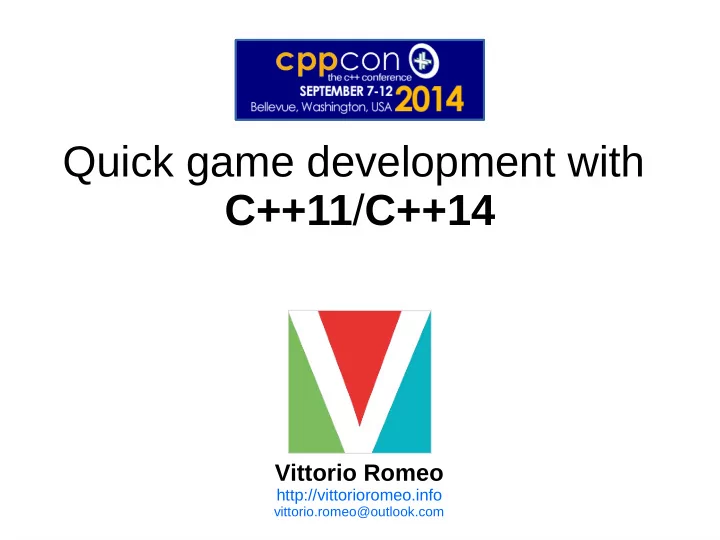

Quick game development with C++11 / C++14 Vittorio Romeo http://vittorioromeo.info vittorio.romeo@outlook.com
About myself ● Computer Science student at the University of Messina ● Autodidact programmer ● Interests: – Software development – Gaming and game- development – C++ and its evolution – Open-source software – Sharing my knowledge Vittorio Romeo http://vittorioromeo.info vittorio.romeo@outlook.com
About this talk ● Introductory part: – Game development: why? ● Why C++? ● Why C++11 / C++14? ● Live coding part: – Preparation: goals, compilers, resources – Live coding : development analysis / walkthrough of a complete playable simple game Vittorio Romeo http://vittorioromeo.info vittorio.romeo@outlook.com
Goals of this talk ● Encouraging everyone to try game development ● Demonstrating how C++ and its newer standards make game development a breeze Vittorio Romeo http://vittorioromeo.info vittorio.romeo@outlook.com
Game development: all-around development experience
Game development: why? ● Game development Mechanics Design Style and feel – Requires knowledge Story and concept and skills in multiple Game development areas Engine and architecture – Involves the Scripting and Implementation customization programmer with the Porting community and distribution – Touches a vast Graphics number of specific Music Resources programming topics Sounds Vittorio Romeo http://vittorioromeo.info vittorio.romeo@outlook.com
Game development: why C++? ● Efficient : zero-cost abstractions and “low- level” code ● Portable : standard- compliant code can target many architectures ● Widespread : huge number of libraries and resources available Vittorio Romeo http://vittorioromeo.info vittorio.romeo@outlook.com
Game development: why C++11 / C++14? ● Convenience , safety and expressiveness – Initializer lists and uniform initialization – auto , range-based for loops factory functions – Lambdas , variadic templates , decltype – override , final , enum class , explicit , nullptr – default , delete ● Memory management ( ! ) entity management – std::unique_ptr , std::shared_ptr , offsetof ● Possible performance improvements – constexpr , std::move , noexcept ● Other improvements / additions – Multithreading library facilities game loop timing – std::tuple , variadic macros , <random> , <chrono> – Generic lambdas , lambda capture expression – auto functions, relaxed constexpr , std::tuple::get<...> Vittorio Romeo http://vittorioromeo.info vittorio.romeo@outlook.com
Let's get started , then!
Live coding: what is our goal? ● Our goal is creating an arkanoid / breakout clone almost from scratch. ● Step by step , I'll demonstrate how easy it is to create a playable game, in around 200 lines of code . Vittorio Romeo http://vittorioromeo.info vittorio.romeo@outlook.com
Live coding: what compiler? ● C++11 support is mandatory – g++ 4.7.2 or clang++ 3.0 (or newer) fully support the C++11 standard ● Some C++14 features will be used – clang++ 3.4 fully supports the C++14 standard – g++ 4.9 supports all the C++14 features we'll be using ● Standard compliance information – http://gcc.gnu.org/projects/cxx1y.html – http://clang.llvm.org/cxx_status.html Vittorio Romeo http://vittorioromeo.info vittorio.romeo@outlook.com
Live coding: SFML library ● To interface ourselves with the input , audio , graphics components of our computer and our operating system we'll use the SFML 2.1 open-source C++ library available at http://sfml-dev.org Vittorio Romeo http://vittorioromeo.info vittorio.romeo@outlook.com
Live coding: code and resources ● You can download the code and the resources that are going to be used here: – http://github.com/SuperV1234/cppcon2014 ● The SFML 2.1 library is available here: – http://sfml-dev.org Vittorio Romeo http://vittorioromeo.info vittorio.romeo@outlook.com
Info: game loop ● The game loop is a Input continuously running loop (until the end of the game) Updat e – 1. Get input – 2. Update game logic – 3. Draw game entities Draw Vittorio Romeo http://vittorioromeo.info vittorio.romeo@outlook.com
Info: coordinate system ● SFML 's coordinate system sets the origin in the top-left corner of the window. X (0, 0) (width, 0) (0, height) (width, height) Vittorio Romeo http://vittorioromeo.info vittorio.romeo@outlook.com
Info: ball movement ● By adding a velocity vector to the ball's position every frame , the ball appears to move. velocity velocity velocity update update update time Vittorio Romeo http://vittorioromeo.info vittorio.romeo@outlook.com
Info: ball vs window collision ● By checking if one of the ball's coordinates is greater or lower than the window's bounds, we can determine if the ball is outside the window. X ball.x + (ball.width / 2) window.width Vittorio Romeo http://vittorioromeo.info vittorio.romeo@outlook.com
Info: AABB vs AABB collision ( top , right ) ( top , left ) ( top , left ) ( top , right ) vertical overlap ( bottom - top ) ( bottom , right ) ( bottom , left ) ( bottom , left ) ( bottom , right ) horizontal overlap ( right - left ) Vittorio Romeo http://vittorioromeo.info vittorio.romeo@outlook.com
Info: ball vs paddle collision ● Depending on where the paddle was hit, we set the ball's X velocity towards the left or the right. Vittorio Romeo http://vittorioromeo.info vittorio.romeo@outlook.com
Info: ball vs brick collision ● We need to change the ball's velocity depending on the direction the brick was hit from. overlapRight overlapLeft Vittorio Romeo http://vittorioromeo.info vittorio.romeo@outlook.com
Info: class hierarchy ● This is the final class hierarchy of our game objects. Entity Rectangle Circle (base) (mix-in) (mix-in) Paddle Brick Ball Vittorio Romeo http://vittorioromeo.info vittorio.romeo@outlook.com
Info: game architecture ● This is the final code architecture of our game classes. Game Manager Entities Grouped entities Vittorio Romeo http://vittorioromeo.info vittorio.romeo@outlook.com
Thanks! Vittorio Romeo http://vittorioromeo.info vittorio.romeo@outlook.com
Recommend
More recommend